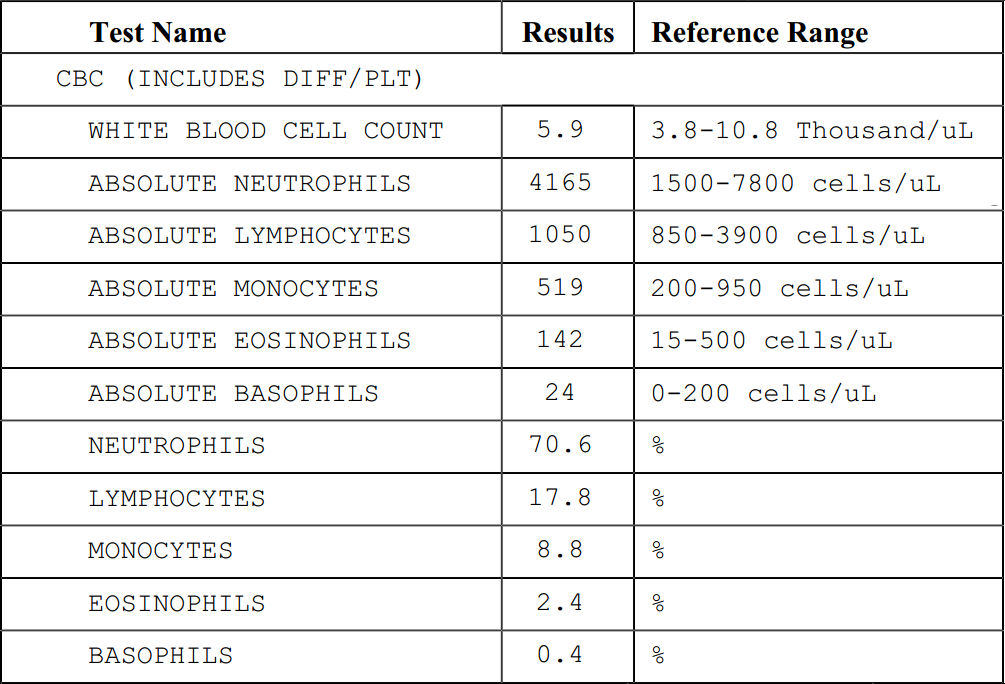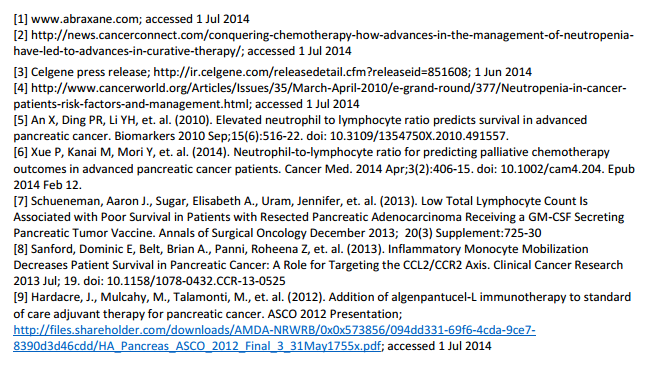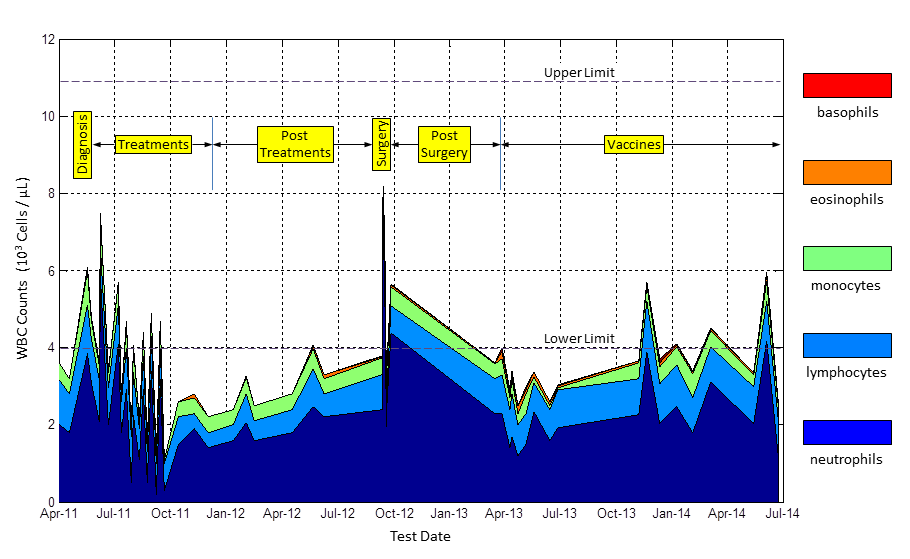In these next posts, I want to explore the effect that chemotherapy, surgery, and my clinical trial vaccine shots had on my white blood cell counts (WBC). I have every lab test result since contracting pancreatic cancer which I’ll use to illustrate some points.
First, a little bit about white blood cells. White blood cells only live for a few days in the body and must be replenished often. This makes them an unintended target for chemotherapy. Their main function is to fight off infections in the body. When a new infection is found, the white blood cell count rises quickly. Chemotherapy prevents the replenishment of these cells and as the existing ones die off, the counts can plummet.
CBC Panel
If you’ve had  a blood test, the results will be a part of the CBC (Complete Blood Count) panel. This test measures the number of blood cells in a micro-liter of blood. I’ve extracted the meaningful lines from one of my recent CBC panels here. There is a total count at the top, followed by individual counts of the five types of white blood cells: neutrophils, lymphocytes, monocytes, eosinophils, and basophils.
a blood test, the results will be a part of the CBC (Complete Blood Count) panel. This test measures the number of blood cells in a micro-liter of blood. I’ve extracted the meaningful lines from one of my recent CBC panels here. There is a total count at the top, followed by individual counts of the five types of white blood cells: neutrophils, lymphocytes, monocytes, eosinophils, and basophils.
White blood cells are measured in two different ways. First, there are the absolute counts for each type. A representative sample of the cells can be counted manually, but its likely been done with an automated cell counter that stains and separates the different types before counting them (divided by size and color). The same cell counts are reported as a percentage of the total count. For instance, the neutrophils are 70.6% of the total count of white blood cells (4.165 / 5.9 = 0.706). Doctors will look to see that the relative percentage of these cells is within their expected ranges as well. This particular laboratory does not list ranges for the percentages, but my cancer hospital does.
The Reference Range column shows the range where they’d like the Results to be between. I’ve found that many hospitals have their own ranges that can differ slightly from the others. It seems to show that there are no hard and fast rules about the ranges. The ranges in this example are provided by Quest Diagnostics.
The following table lists published references concerning pancreatic cancer for the various White Blood Cell Counts. In subsequent postings, I will review these in more detail. For now, here is the list and linked references.
Implications of WBC on Pancreatic Cancer
| WBC Type | Pancreatic Cancer Implications |
| Neutrophils | <1500 cells/μL : Halt Abraxane therapy [1]
|
| <500 cells/μL: Halt GAX therapy, resume when >1500 cells/μL [3] |
| <500 cells/μL + fever -> immediate antibiotics |
| neutropenia + illness -> febrile neutropenia -> septicemia -> organ failure [2] |
| febrile neutropenia risk is greatest on first chemo cycle [4] |
| In advanced PC, NLR>5 predicts shorter survival times [5][6] |
| Lymphocytes | GVAX Vaccine, <1500 cells/μL: lower OS, PFS [7] |
| Monocytes | In resected patients, the monocyte % is related to decreased survival [8] |
| Eosinophils | Gemcitabine + 5-FU-XRT + Algenpantucel-L: 70% of patients developed eosinophilia, some lasting up to 2 years [9] |

WBC/Pancreatic Cancer Implications
Neutrophils
Neutrophils are the infection fighters – the first to arrive at an infection site to ingest bacteria, fungi, or protozoa and when they die en mass they form pus. Neutrophils are the most numerous of all white blood cells, living up to a few days. During chemotherapy, we’re most interested in the neutrophil count. A drop in this count below 1000 cells/µL (neutropenia) may trigger a halt in treatments and/or earn you daily neupogen shots to boost your counts. The drugs Neulasta® and Neupogen® stimulates the bone marrow to produce more neutrophils. A low neutrophil count can cause a minor illness to quickly become major if not enough of these cells are there to eliminate the cause.
Sometimes a blood test result will list the neutrophil count as ANC which stands for Absolute Neutrophil Count.
Neutropenia Grade and Severity
| ANC Range | Grade | Severity |
| 0 | - | 500 | cells/μL | 4 | Severe |
| 500 | - | 1000 | cells/μL | 3 | Moderate |
| 1000 | - | 1500 | cells/μL | 2 | Mild |
| 1500 | - | 2000 | cells/μL | 1 | |
| 2000 | - | | cells/μL | N/A | Normal |
Lymphocytes
Lymphocytes are composed of B, T, and natural killer cells. A subtype of these cells retain a “memory” of previous infections or viruses and attack diseases we’ve previously been exposed to. The vaccine clinical trial I’m enrolled in is trying to train lymphocytes to recognize pancreatic cancer cells, eliminate and retain a memory of them. This article describes how patients with low lymphocyte counts (<1500 cells/μL) receiving the GVAX vaccine are associated with poor survival statistics.
Monocytes
These are the largest of all white blood cells, living up to a few days. About ½ of all monocytes reside in the spleen, unless it has been removed.
An interesting study linking lower monocyte counts to increased survival in resected pancreatic cancer patients is here. The authors divided the resected patients into three groups based on monocyte percentage of all white blood cells (see table) and found that the lower the monocyte percentage, the longer patients survived.
Eosinophils
Eosinophils combat multicellular parasites and are associated with allergies and asthma. These cells may live up to 12 days waiting to fight off bad guys.
Basophils
These are the least common of the white blood cells and are also associated with allergies and asthma. They live a up to a few days.
Wrapping Up White Blood Cell Counts
Below I show my white blood cell counts starting just before diagnosis, through chemotherapy, surgery, and finally the vaccine treatments I’m still getting through my clinical trial. The five types of white blood cells are all shown separately and indicated by their own colors. In the next few posts, I’ll zero in on each of these separately to show what went on in more detail.

David Dessert White Blood Cell Counts
You may notice that my white blood cell counts are on the low side. My total WBC “normal” reading is below the 4000 cells/μL lower limit. I’ve found that for some athletes in highly aerobic sports that a lower WBC is normal. I spend around 12 hours for >200 miles on the bicycle each week which I hope is the reason for these low counts. I’ve often been asked if I am feeling well after the doctors get my WBC results. I present this historical record to show that these low readings are normal for me.

 a blood test, the results will be a part of the CBC (Complete Blood Count) panel. This test measures the number of blood cells in a micro-liter of blood. I’ve extracted the meaningful lines from one of my recent CBC panels here. There is a total count at the top, followed by individual counts of the five types of white blood cells: neutrophils, lymphocytes, monocytes, eosinophils, and basophils.
a blood test, the results will be a part of the CBC (Complete Blood Count) panel. This test measures the number of blood cells in a micro-liter of blood. I’ve extracted the meaningful lines from one of my recent CBC panels here. There is a total count at the top, followed by individual counts of the five types of white blood cells: neutrophils, lymphocytes, monocytes, eosinophils, and basophils.
